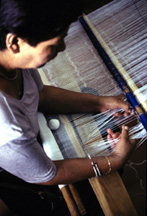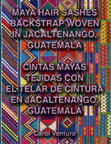 |
BACKSTRAP WEAVING |
 |
 |
 |
 |
| Loom / Telar |
Jacaltenango Guatemala |
Santa Maria del Rio / Santa Maria del Rio, Mexico |
Morelia, Mexico |
 |
BACKSTRAP WEAVING |
 |
 |
 |
 |
| Loom / Telar |
Jacaltenango Guatemala |
Santa Maria del Rio / Santa Maria del Rio, Mexico |
Morelia, Mexico |
 |
 |
Tenganan, Bali |
Sideman, Bali |

|
For a closer look, you might enjoy Maya Hair Sashes Backstrap Woven in Jacaltenango /
Cintas mayas tejidas con el telar
de cintura en Jacaltenango, Guatemala, a bilingual book that features the Jakaltek
backstrap loom,
backstrap weaving,
and the beautiful hair sashes of the Jakaltek women, from both anthropological and artistic perspectives.
The 176 page paperback book includes 38 illustrations, 116 black and white photographs, and 15 color photographs
(ISBN 0-9721253-1-0). You may order a signed copy of this book with a credit card by clicking the "buy now"
button on the left (in the US only - includes free postage). |
Maya Hair Sashes . . .
Book Reviews:
Journal of Latin American Anthropology, November 2005
. . . The precise documentation of the tools and
techniques of the weaving process of the hair sash in Carol Ventura's bilingual
work is a propos here since it deals with the preservation of knowledge of the
tradition. For Ventura, the artist and art historian, 1986 was the culmination
of four and one-half years of working with the Jakaltek weavers in Guatemala.
Her view of the learning process at that time, which included learning by
observation and use of the toy loom, accords with Greenfield. Ventura returned
in 1996 and in 2002. Although in 1986 weaving was an important activity that
established group identity and social cohesiveness, by 2002 weaving was rapidly
disappearing. The weaving cooperative had become a general store and there was
less foreign demand for hair sashes and wall hangings. The hair sash designs had
evolved from simple geometric patterns to elaborate designs appropriated from
German silk ribbons. It was the only item of local dress still woven in 2002 in
Jacaltenango. This and the fact that Jakaltek textiles are still a commodity
will, in Ventura's opinion, keep weaving alive in the near future. The picture
given by Ventura of the changes between 1986 and 2002 is very much in keeping
with those mentioned in the previous two books. Communication and contact via a
road system and technology; the telephone, television, and the Internet -
provide contact with the broader world. More schools and a university branch
have widened horizons. A cash economy and the remittances sent by emigrants have
enabled economic life will beyond subsistence levels, much as the
commoditization of textiles has empowered women. . . Virginia Davis
Choice,
November 2004, 42.3: 473
Contemporary Mayan material culture has received cursory attention from scholars
outside of its relevance to ancient Mesoamerica studies. Textile production and
trade have been intrinsic to the life of Mayan peoples since before the Common
Era, but much about their history remains unknowable. Ventura (Tennessee
Technological Univ.), a compassionate historian and skilled weaver, documents in
detail the history, method, style, and patterns in the backstrap-woven hair
sashes worn and sold by Jakaltek women living in a remote area of modern
Guatemala. Sections on Mesoamerican religion and mythology and pre-Columbian
symbolism of weaving, in conjunction with a useful bibliography in English and
Spanish, makes this a key resource for historians, anthropologists, and
practitioners. Ventura contributes the first comprehensive account of the
backstrap looming method and the conservation and transformation of traditional
patterns and their meanings, including templates and step-by-step instructions
for weavers. All documented areas are supported by carefully composed
photographs of Jakaltek people and places, especially women working at their
looms, and legible close-ups of many specific sashes. Unfortunately, very few
illustrations are in color; color is significant to several designs that, in
some cases, have revealed for generations the social status of individual
Jakaltek women. Summing Up: Highly recommended. General readers; lower-division
undergraduates through professionals. M. R. Vendryes, York College, CUNY
Handwoven, May/June 2004: 20-21
Carol Ventura, also the author of books on
tapestry crochet under the name Carol Norton, learned to weave Jakaltek hair
sashes while serving as a Peace Corps Volunteer in Guatemala in the late 1970's.
She learned to speak Spanish and the local language, Popti', and spent several
years working with the Jakaltek weavers of Jacaltenango. Her doctoral
dissertation on hair sashes was published in 1989. The first edition of this
book was published in 1996 by Yax Te' Press.
The Jakalteks have lived in the highlands
of northwest Guatemala since pre-Columbian times. The women maintain their
traditional clothing style. The hair sash is the only item that is still locally
woven. It is an important trade item and is exported worldwide.
While the designs on the sashes may appear
to be embroidered, they are actually created as the fabric is woven. Jakalteks
use a double-faced supplementary-weft brocade technique to create a variety of
geometric and pictorial motifs on a warp-faced fabric.
This is more than a book documenting hair
sashes. The technical information includes a valuable analysis and comparison of
forty-five hair sashes collected between 1927 and 1989. In addition, a wealth of
historical background is presented in a very readable style. One chapter
summarizes the development of weaving in the area, beginning with the first
evidence of pre-Columbian textiles. The fibers and the tools used to create the
hair sash, as well as the double-sided brocading technique used by the weavers,
are all well documented. Black-and-white photos show the steps involved in using
the warping frame and the loom - there is even a photo showing a blind man
making a ply-split backstrap from 2-ply sisal. Another chapter documents the
physical and spiritual importance of weaving and clothing to the Jakalteks that
includes sections on pre-Columbian cosmology, weaving deities, and the symbolism
of huipiles, hair sashes, colors, and motifs.
Many interesting footnotes supplement the
text, along with charming photographs of women warping and weaving. The four
pages of color photographs show over fifty sashes, and the instructions will
enable readers to reproduce the designs. Anyone interested in weaving should
enjoy this book, especially those who want to know more about Guatemalan
Textiles. Linda Hendrickson
Links:
Toba Sashes of
Argentina Pickup Technique
Foot-Loom Weaving in Central Mexico
Ikat Shawls of Uriangato and Moroleon, Mexico
Gobelin Tapestry Weaving in Dolores Hidalgo, Mexico
Haida cedar bark hat maker, Gladys Vandal
Mexican Cane Baskets
Los Lenateros Papermaking, Printmaking, and Book Arts Studio
Shibori in Kyoto, Japan
Katazome (stencil dying) in Kyoto, Japan
Tapestry Crochet
Carol Ventura's Home Page
Carol Ventura's Publications
This web page is maintained by
Carol Ventura